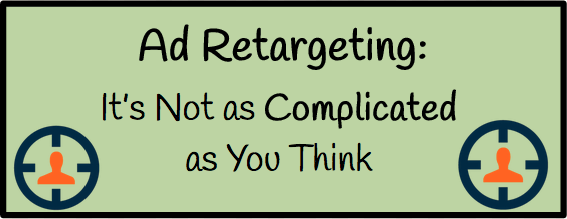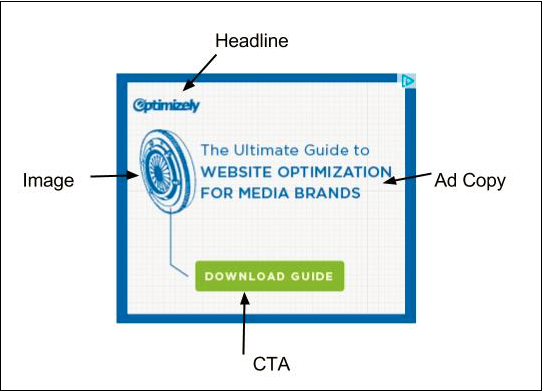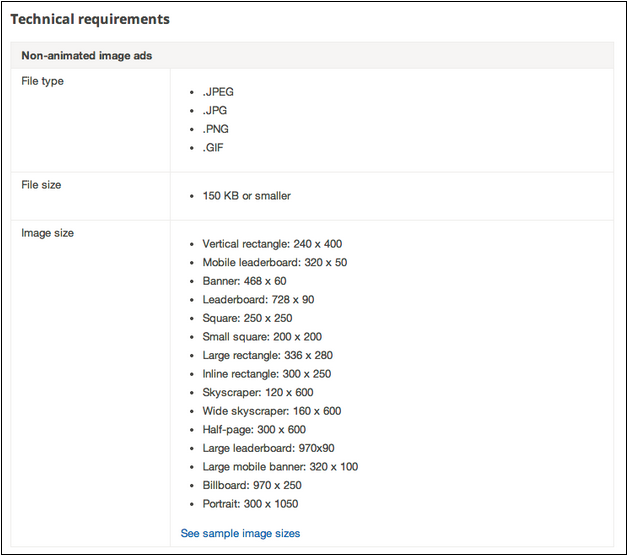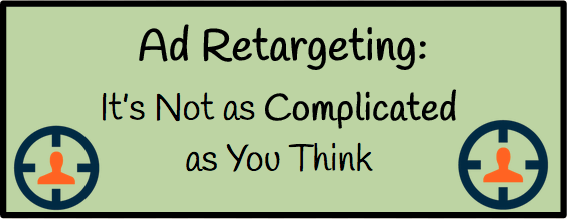
Remarketing is one of the fastest growing areas in online marketing. Google first introduced remarketing ad options years ago, and now Facebook has them too.
You might think most people who use them are savvy online marketers with years of experience in the digital space. But remarketing doesn’t have to be overly complicated – or hard to do.
If you are new to online marketing, starting with remarketing, or just don’t have the time or resources to build and manage a complex, segmented, multi-path retargeting campaign, you’re reading the right article.
In this post, I’ll walk you through the basics of remarketing and give you the one simple strategy you need to get results right now.
Note: Remarketing is also commonly known as retargeting – Google uses the term ‘remarketing’, everyone else tends to use the term ‘retargeting’. I’ll be using both terms interchangeably in this article.
What is Remarketing?
First things first. Just what is remarketing anyway?
You may know that 98% of first time visitors to your site are not going to immediately buy from you. Wouldn’t it be cool if you could somehow remind your unconverted, bounced traffic of who you are, increase your consumer touchpoints and even persuade that lost visitor to come on back and buy from you?
That’s what retargeting can do.
You’ve probably experienced remarketing in action. You’ve visited a website, left it for whatever reason (your webinar started, your cat needs feeding, or you really do need to get back to the thing you were intending to do), then as you’re sifting through other websites or listening to music on 8tracks, you see an ad from the website you were visiting earlier. Their branded image keeps following you around, and you start to feel familiar with who they are. Before you know it, you’re back on their website, converting with an ebook download or even purchasing their product.
That’s remarketing.
How to Create a Simple Ad Retargeting Campaign
If you’re making a basic remarketing ad, it’s not that difficult to set up. Whether your objective is to gain brand awareness or generate clickthroughs for conversions, setting up one campaign can be done in three simple steps.
The three steps to technically set up a campaign are:
1. Create a remarketing campaign in Google AdWords, Facebook, or a third party ad provider (like Wishpond).
2. Create your retargeting ad by following the steps of your ad provider. You need a memorable headline, an eye-catching image, persuasive and short ad copy, and an irresistible Call-to-Action (CTA). We’ll go through the elements of a high converting ad in the next section – stay tuned.
3. Add a remarketing tag to your website. This is a snippet of code you copy and paste to embed on your entire website. Paste the code on all the pages from which you want to remarket bounced traffic to (for example, your homepage, pricing page and specific landing pages). The code looks something like this:

When someone bounces from your site, they get a ‘cookie id’. Your cookie (now in their browser) follows your lost traffic as they visit other sites.
Your branded ad can be shown wherever they are online – you don’t have to guess which sites they’re going to be on.
Create the Perfect Retargeting Ad
The better your ad is optimized and personalized to reflect your business and your website visitor, the more likely your ad is going to achieve the results you need.
There’s four main components of a successful retargeting ad:
- Headline
- Image
- Ad Copy
- Call to Action

Let’s dive in to the best practises of each component:
Headline
For a remarketing campaign that’s focused on brand awareness, use your company name and logo as part of your headline. You could include a short tag line too, so long as it doesn’t detract from visitors remembering your brand name.
If you’re using remarketing for other objectives such as increased click-through rates for sales or lead generation, use headlines that invoke an action, such as including the word “free”, “we miss you” or “download your ebook…”.
Image
The image on your retargeting ad is generally the first thing people see on your ad. Make it eye-catching and memorable. If you’re making a brand awareness campaign, your image should be related to your business brand such as the face of your CEO, your brand mascot or even an image of your latest product offerings (so people recall why they visited your site in the first place).
Use a high quality image that’s large enough to clearly see in your ad. Don’t use overly detailed images that are hard to see at a glance. And definitely, leave white space in your ad, and room for your Headline, Text and Call to Action (CTA).
Check out more image tips for Facebook Ads.
Take your brand awareness deeper, by using your website color scheme in your background.
Image sizes
Use multiple image sizes so that it can be viewed on more of the Google Display network sites.
There’s actually 15 different sizes you can use with a standard image:

Note: You can also use .gif, HTML5 and Flash images – but for a first ad, stick to the basics and understand the ins and outs of what you’re doing first. Kind of like learning to walk before you run.
The most common sizes are 300×250, 728×90 and 160×600.

Personally, I prefer to start with the 300×250 pixel image ad, as they tend to generate the most impressions. Then I A/B test the ad images to find the winner. Then I’d make the image in other sizes too.
Persuasive Ad Copy
Your copy could be as simple as your optimized tagline. This is particularly true when your objective is to increase brand awareness. The more consistent the touchpoints your bounced traffic has with you, the more likely they’ll remember who you are and what you do.
Use pertinent keywords in your copy that will resonate with your market. Use capitalization and bold to draw attention to your keywords.
If your Ads are for click-throughs, succinctly write out 1-2 of your benefits that will seal the deal for getting the click. Retargeting ads are not huge, so keep your benefits to a maximum of 9 to 10 words. Make them easy to read and show why someone should click. Make it a question, and use words like “easy” and “free”.
Call to Action (CTA)
Your CTA is the ask you’re making of your viewers, so make it stand out. After your image, it should be the next thing that captures attention in your ad. Make a CTA button that color contrasts with your background. For example, if your ad is blue use an orange CTA button. If your ad is yellow, use a green CTA button.
Your CTA should motivate action.
If your objective is a clickthrough, use action words like:
- “Download Now”
- “Find out More”
- “Buy it Now”
Check out more CTA tips for your retargeting ads.
Create the Right Ad Retargeting Time, Frequency and Budget
A really cool feature about ad remarketing is that you can set not only the duration of your campaigns, but you can also cap the frequency you want your ads to be seen by your bounced traffic. Once you’ve created the perfect ad, think about when and how often to show it for optimal results.
Keep in mind that your ad will show up on any site your traffic is visiting – so long as it’s part of the Google Ad Display Network, or on Facebook.
If you set your ad campaign to follow your bounced traffic for say, a month, you’re not going to want to show your ad every day. You’ll give the impression of being spammy and ‘in your face’ – not really something most visitors find appealing.
Ad Campaign Duration
Set the time frame of your ad by using Google’s remarketing Member Duration. This means your ad will show to each bounced visitor for number of days you indicate.

It’s not like regular online advertising where you set a campaign start and end date. The campaign starts when someone visits your page and bounces – keeping your cookie on their browser.
If you’re using the campaign for brand awareness, set the duration for 30 days, to keep your brand front and center after someone first visited your site.
If you’re using the campaign for an immediate click-through (whether for sales, lead gen, contests or what have you), set the duration for a shorter time.
Remarketing Frequency Capping
You can also set the number of times your ad will be displayed in a day, week or month. Set up a frequency cap that gets your brand seen and familiar but doesn’t also frustrate your market by seeing your ad all the time!
If you’re running the campaign for a month and your objective is brand awareness, set your ads to show a few times per week
If you’re running the campaign for 10 days, and you want an immediate clickthrough, show your ads more frequently.
As with any online advertising campaign, it pays to regularly check your analytics to determine what duration and frequency gives you optimal results.
Budget
Another factor to consider is, of course, your budget. The more times your ad shows (if you’re using CPM) or gets clicks (if you’re using CPC), the more it costs you.
Determine the value of your objective. If you’re using the remarketing campaign to increase brand awareness – what’s the bottom line worth to your business? If you’re using the campaigns for a sale conversion – how much margin can you spend on advertising?
Let’s take a look at a budgeting process for the sale of a t-shirt you’re selling online. Let’s say the t-shirt costs you $10 to make, and you’re selling them online for $20. Your profit margin is $10/ single sale, or 100%.
To sell more t-shirts, you realize you need to market your goods to more interested buyers. You use retargeting campaigns. By budgeting $20/day (or $140/ week), your ad is shown to about 5,000 unique visitors per week (based on industry average). Of those 5,000 visitors, 2% convert. You sell 100 t-shirts in a week.
This gives you an ad retargeting ROI of $1000 ($10/shirt x 100) – $140 (in ad retargeting costs) = $860.
That’s $860 in a week – that you wouldn’t have made without an optimized ad retargeting campaign.
Of course, this is a hypothetical example, and every ad campaign ROI will vary.
Track, Test and Measure Results
Always track the performance of your online ads. Set up metrics based on your campaign objectives.
If your goal is to increase brand awareness, for example:
- Measure ad retargeting impressions to track how many visitors see your ads
- Set up brand monitoring (such as Google Alerts, or paid monitoring that can monitor brand sentiment etc., like Social Mention, Brand Watch or Com Score)
- Track website traffic with Google analytics or your own website metrics
Test your ads with A/B testing. Make two variations of your ad, and use an A/B testing software to split test your ads by showing 50% of viewers variation ‘A’ and 50% variation ‘B’. Track the results you need – such as clickthroughs. If one ad performs significantly better, use that ad going forward.
Measure your campaign results. The more concrete you are with your bottom line dollars, the better you can prove your worth as a marketer – and your results in online remarketing.
For a brand awareness remarketing campaign measure:
- Impressions – by using a CPM (cost per a thousand) campaign to measure how many views your ads get.
- Customer engagement – by tracking your clickthrough rate (CTR).
- Reach and Frequency – by tracking your frequency capping and ad views.
Conclusion
Remarketing doesn’t have to be super complicated. Try out these steps and see the results for yourself.
Learn more about retargeting:
- What is Ad Retargeting (Remarketing) and How Does it Benefit My Business?
- Ad Remarketing: Fundamentals of the Google Display Network
- Retargeting: The 10 Stats you Probably Didn’t Know
- Introduction to Retargeting with Petey the Pixel (Slideshare)
- Three Ways to Use Retargeting to Find Success Online (with Petey the Retargeting Pixel)
What do you think? Have you had success with remarketing? Share your smart strategies.
Written by Krista Bunskoek @ Wishpond
Get my comprehensive guide to Google AdWords – it’s FREE
 BannerGoogleAdwrods.png” title=”” />
BannerGoogleAdwrods.png” title=”” />

